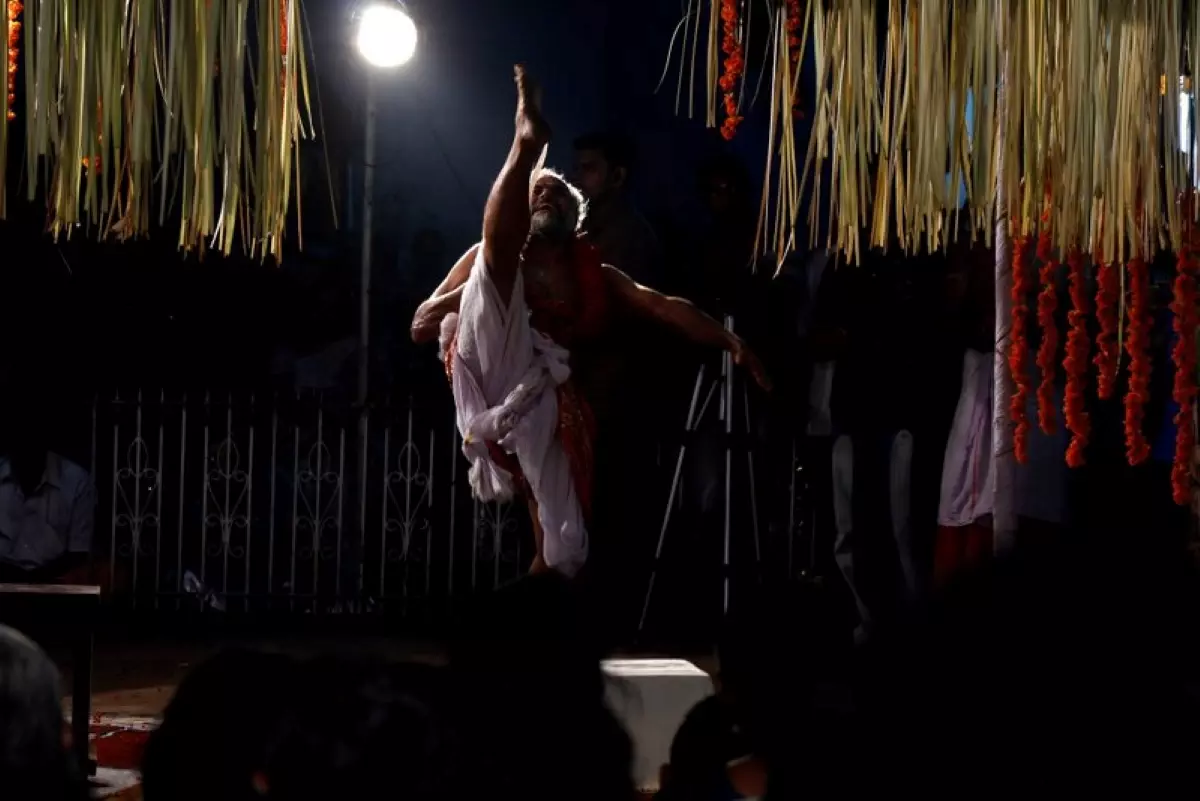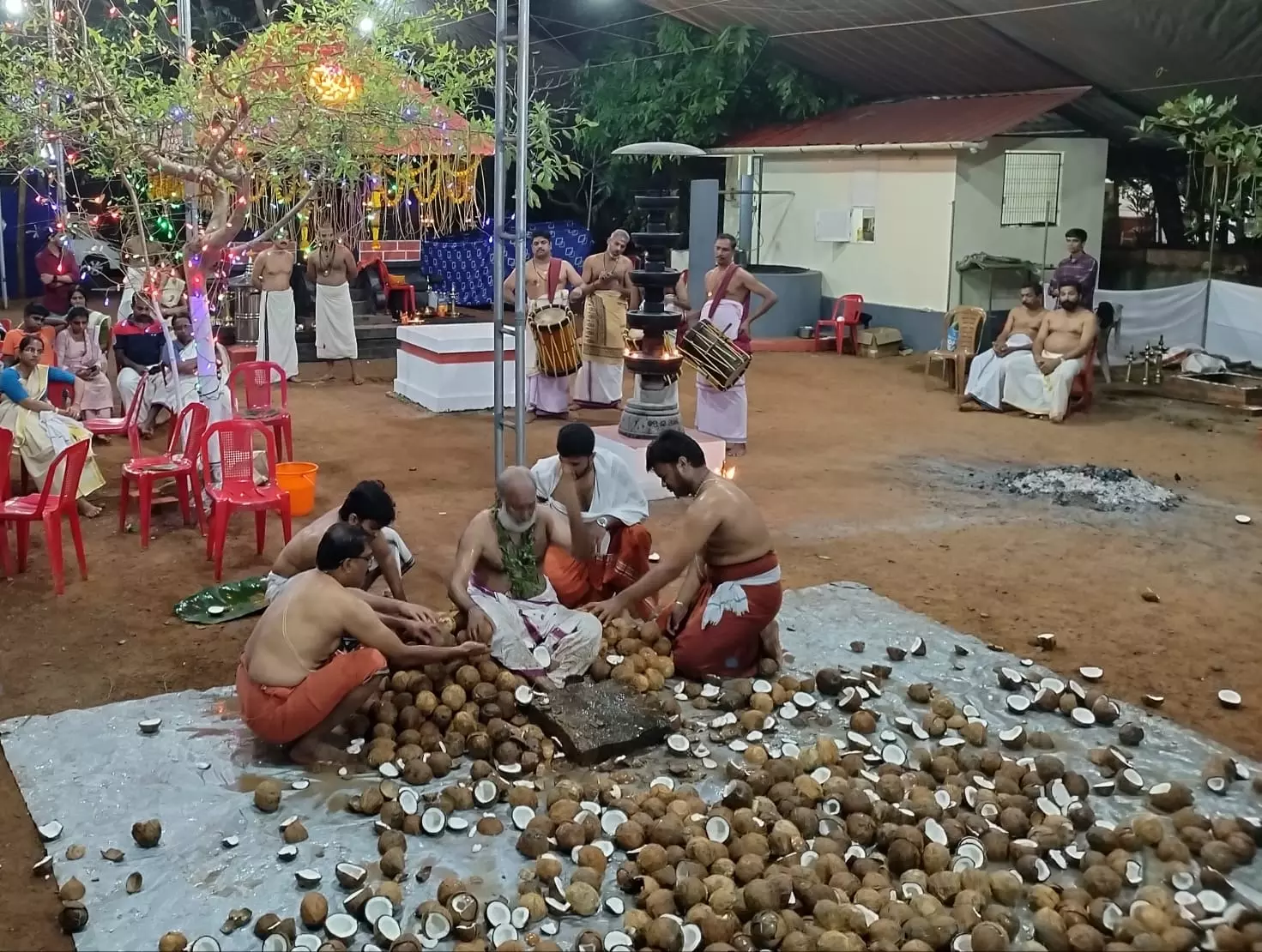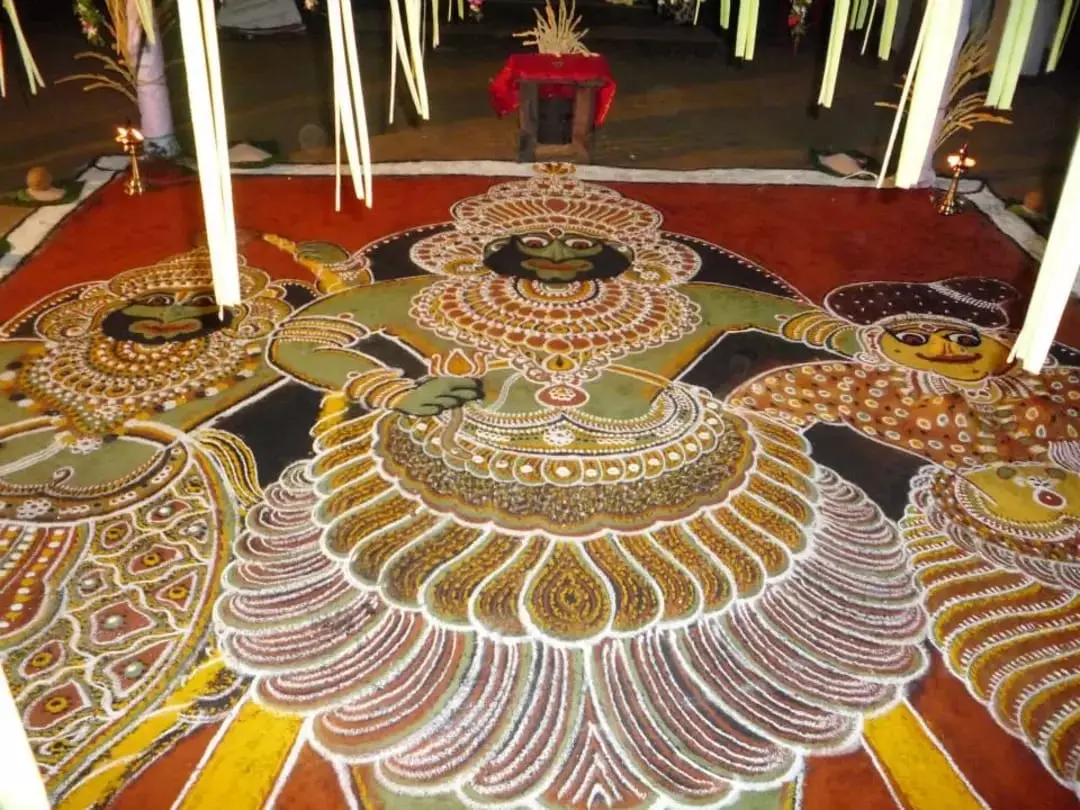
- Home
- India
- World
- Premium
- THE FEDERAL SPECIAL
- Analysis
- States
- Perspective
- Videos
- Sports
- Education
- Entertainment
- Elections
- Features
- Health
- Business
- Series
- In memoriam: Sheikh Mujibur Rahman
- Bishnoi's Men
- NEET TANGLE
- Economy Series
- Earth Day
- Kashmir’s Frozen Turbulence
- India@75
- The legend of Ramjanmabhoomi
- Liberalisation@30
- How to tame a dragon
- Celebrating biodiversity
- Farm Matters
- 50 days of solitude
- Bringing Migrants Home
- Budget 2020
- Jharkhand Votes
- The Federal Investigates
- The Federal Impact
- Vanishing Sand
- Gandhi @ 150
- Andhra Today
- Field report
- Operation Gulmarg
- Pandemic @1 Mn in India
- The Federal Year-End
- The Zero Year
- Science
- Brand studio
- Newsletter
- Elections 2024
- Events
Ayyappan Theeyattu, Kerala’s ritualistic theatre form, opens its doors to a female artist
In a historic first, RLV Aryadevi Thiyyadi performs Kerala’s centuries-old ritual art of Ayyappan Theeyattu, once the sole domain of men, honouring her father and tradition and challenging taboos

Ayyappan Theeyattu is a ritualistic art form with centuries of tradition, performed in temples, illams (traditional Brahmin houses), and other sacred places in the central and northern parts of Kerala. This art form, predominantly male-oriented, serves as an offering to honour Sastha (Ayyappa), narrating the stories of his life, especially through the thottam and koothu styles....
Ayyappan Theeyattu is a ritualistic art form with centuries of tradition, performed in temples, illams (traditional Brahmin houses), and other sacred places in the central and northern parts of Kerala. This art form, predominantly male-oriented, serves as an offering to honour Sastha (Ayyappa), narrating the stories of his life, especially through the thottam and koothu styles. Ayyappan Theeyattu features a blend of kalam (floral drawing), paatu (song), koothu, and komaram (oracle dance). The smashing of 12,000 coconuts at the conclusion is intended to appease the 12,000 bhootaganas (lieutenants) of Lord Shiva.
Performed by members of the eighth Thiyyadi Nambiar families, a community linked to temple activities in Kerala, the art form has only a few practitioners today. A lack of interest and financial support threatens its existence. A week ago, Ayyappan Theeyattu experienced a significant transformation. RLV Aryadevi Thiyyadi, a Kathakali artist and the daughter of senior Theeyattu performer Mulankunnathukavu Thiyyadi Raman Nambiar, performed koothu, an important part in Ayyappan Theeyattu, for the first time in the history of this art form. Aryadevi’s performance was a tribute to her father, who celebrated his 70th birthday on July 26, and it took place at a school in Thrippunithura in the Ernakulam district of Kerala.
Also read: Mysuru Dasara may see Abhimanyu’s last walk as Golden Howdah bearer this year
Raman Nambiar is known for elevating the art form which had been limited to Sastha temples and illams into the public sphere. When his daughter voiced her desire to perform, Raman supported her, as he wished to ensure the continuity of the tradition after his time. Although Ayyappan Theeyattu was traditionally performed only by men, Aryadevi had been acquainted with the art form since her childhood, as Raman regularly trained young individuals in his community at their residence. Given the scarce opportunities for women to perform, she pursued other interests such as drawing and Kathakali. As time went on, she mastered both disciplines, yet her enduring passion to perform Ayyappan Theeyattu persisted.

Thiyyadi Raman Nambiar as oracle in Ayyappan Theeyyattu, which he performed in Thrissur recently
“It was an exceptional event, and I received support from everyone who attended to watch my performance,” said Aryadevi, who believes that her knowledge of Kathakali contributed to her ability to perform the Koothu. “Although I am acquainted with Theeyattu, I felt somewhat anxious at the start since this was my debut performance. However, my background in Kathakali proved to be immensely beneficial. I am pleased that I was able to perform the Koothu, a crucial segment in Ayyappan Theeyattu, for almost two hours. I am thankful to my father, as well as my cousins and brothers, who assisted me in my performance,” she said.
Although Aryadevi’s participation represented the inaugural occasion for a woman engaged in Ayyappan Theeyattu, Raman found it difficult to permit his daughter to engage in the art form. “Some of my relatives warned me of dire repercussions should a woman take part in the art. They claimed it was inappropriate and that the deity would punish me for allowing a woman to perform it. I was not concerned with such trivial beliefs, and I wished for her to proceed. Thus, everything unfolded positively, and I am pleased that it occurred on my 70th birthday,” said Raman, who has been performing Theeyattu since he was 10 years old.
Since childhood, Aryadevi has been acquainted with the art of singing and acting. “Her father, who is both a practitioner and a theoretician, also serves as a teacher to the younger generation. While instructing his close relatives in the art of singing at home, Aryadevi, along with the boys, memorised the lyrics, the rhythm, and the beats of the Koothu and Komaram. However, as a girl, she found herself unable to physically express any of these elements. A week ago, when she got the opportunity, she performed with a sense of courage and devotion,” said art-writer T K Sreevalsan, who incidentally gave a couple of refresher classes to his cousin Aryadevi ahead of her debut Koothu. For Aryadevi, it was not an overnight affair. A decade ago, she started composing Kalam (multi-coloured floral depiction of Lord Ayyappa using five primary colours and traditional designs), which plays a prominent role in this ritualistic art form.

Kalamezhuthu, floral drawing of Lord Ayyappa
Although Raman adhered to the traditional format of the art form passed down from his ancestors, he recognised that several aspects of the Ayyappan Theeyattu required refinement. During the 1970s and ’80s, Ayyappan Theeyattu was presented in numerous temples as part of a ritual. According to Raman, the artistic dimension of this performance was often overlooked. “In those days, Ayyappan Theeyattu was strictly ritualistic. The artistic components, such as Kalam, Koothu, Paatu, and Komaram, were eclipsed by the ritualistic elements. Many esteemed Theeyattu artists passed away without receiving the recognition they rightfully deserved because of this. However, a transformation began in the late 1990s when we started performing beyond the confines of temples and illams,” said Raman.
In Ayyappan Theeyattu, one can observe the merging of dance (nritta), music (paatu), vadya (instruments), and the magnificent floral drawings. This performance is carried out by the Thiyyadi Nambiars, a microscopic community consisting of eight families dispersed across the Thrissur, Palakkad, and Malappuram districts of Kerala. The eight Thiyyadi Nambiar families that currently perform Ayyappan Theeyattu are Mulankunnathukavu, Cheruppulasseri, Elamkulam, Mundamuka, Thayamkavu, Irinjalakkuda, Malamakkavu, and Perumpilavu.
Paalazhimathanam, a tale from Hindu mythology, serves as the foundational narrative for Ayyappan Theeyattu. Although the gods successfully obtain the amrithu (ambrosia) with the assistance of Brahma, Vishnu, and Siva, the asuras manage to steal it and transport it to asurapuri. In a clever move, Vishnu disguises himself as a beautiful maiden, deceives the asuras, retrieves the amrithu, and ultimately feeds it to Indra, thereby lifting the curse placed by Sage Durvasa. From the divine union of this vishnumohini and Shiva, Ayyappa is born. The narrative is segmented into 12 parts, with the final segment, known as Sankaramohanam, being the most important and frequently performed.
When Indra taunts Sastha regarding his lack of understanding of grihastashrama and kamasasthra (which is forbidden for Brahmacharis), Sastha swiftly counters Indra’s claims by marrying Prabha and fathering a son named Sathyaka. Therefore, the Ayyappa depicted in Ayyappan Theeyattu is not the same as the one you see in Sabarimala. The Sastha here appears with a bow and arrows and is accompanied by his wife, son, and 12,000 bhootaganas.

The smashing of 12,000 coconuts at the conclusion is intended to appease the 12,000 bhootaganas (lieutenants) of Lord Shiva.
Numerous sessions are linked to Ayyappan Theeyattu. The ritualistic art form commences with Koorayidal, or flag-hoisting. Uchappattu is an occasion where songs are sung rhythmically to invoke the main deities. Kalamezhuthu is a key session where floral representations of Ayyappa are created in various forms, using five primary colours. The Kalam is adorned with tender coconut leaves, betel leaves, rice, and coconut. While Paattu is performed in the Kalampattu style, Koothu focuses on the background story of Ayyappa. Thiri Uzhichil is a ritualistic pooja and Mullakkalpattu is carried out during the final scene of action by the oracle dancer. Eadum Koorum is a dance characterised by intricate steps performed by Komaram, representing the most captivating aspect of the art form. Kalapradakshinam is another variant of tantric dance executed by the oracle. Kalathilattam signifies the peak moment when the oracle leaps into the Kalam. Thengayeru refers to the continuous breaking of 12,000 coconuts in a rhythmic manner. The oracle’s Kalpana, following a few spoken words, along with Kooravalikkal, signifies the formal conclusion of the ritual.
Udayastamanam (dawn-to-dusk) Koothu is a complex variant of Ayyappan Theeyattu. The performer who enters the mandapam for Koothu is prohibited from consuming food or water until the performance concludes in the evening. Only an experienced individual can manage this task. It cannot be performed solo. Kanalattam, on the other hand, represents the most perilous role within Ayyappan Theeyattu. One must exercise extreme caution. Similar to Udayasthamana Koothu, only a skilled performer can successfully undertake this hazardous role.
In 2000, Ayyappan Theeyattu experienced a big transformation as it began to be performed in private venues outside the traditional temples where it had previously been held. This shift in demand altered the overall structure of the performance, placing greater emphasis on artistic elements while still preserving its traditional ritualistic essence. “Although there were eight Thiyyadi Nambiar families, only members from four temples had permanent Thiyyadi artists to perform Ayyappan Theeyattu. The other temples do not employ permanent artists; instead, they hire artists on a temporary basis to conduct the events. Due to the lack of a stable income from this art form, many young individuals in these families have chosen to pursue other careers,” said T S Vasunni, an Ayyappan Theeyattu artist and former Kathakali professor at Visva-Bharati, Shantiniketan, West Bengal.
Also read: How Dharmasthala, Karnataka’s temple town, struggles to shake off its shame
“Despite the efforts of senior Theeyattu artists to attract younger generations to the art form, it continues to pose a greater challenge. It was only after my retirement that I began to perform Ayyappan Theeyattu on a regular basis. There are many individuals like myself who are employed in various fields and cannot rely on this art form for their livelihood. Nowadays, living expenses are escalating rapidly, and it is impossible to sustain oneself on the minimal compensation received from this art form,” he added.
Positive transformations are always appreciated, according to Bhadra Rajaneesh, a performer of Thayambaka-Koodiyattam and a Sanskrit lecturer at Sreekrishna College in Guruvayur. Bhadra was responsible for renting and designing Aryadevi’s Theeyattu costume. “I was raised in an area where Ayyappan Theeyattu was showcased, but I first learned about it over a decade ago, particularly after my encounter with the maestro, Raman Nambiar. Our discussion regarding this art form enlightened me, revealing numerous intricate aspects that require thorough study,” said Bhadra, acknowledging the difficulties she faced in carving out her niche as a Thayambaka (solo Chenda performance) artist in a predominantly male field a decade ago. “When a woman enters a male-centric domain, there is often considerable encouragement and support, albeit stemming from curiosity. Alongside my sister, I have performed at over 70 venues as a Thayambaka artist. Ultimately, it is talent that prevails. There are more secular venues today and I hope it will help,” she added.

Floral painting (Kalam) is an important part of Ayyappan Theeyyattu
T S Parameswaran, a performer of Ayyappan Theeyattu, said that while changes are appreciated, the integrity of the ritualistic elements of the art form must be preserved. “The rituals of Ayyappan Theeyattu are pure and have been passed down through generations. I only perform at venues associated with the temple. My late father, Sankaran Nambiar, always advised me to remain true to the temples. I hold a deep commitment to my ancestors, through whom I continue to practise this art form today. I will never compromise on this,” said Parameswaran, who has been performing Ayyappan Theeyattu since 2000.
Haridasan Kurup, a senior singer of Kalamezhuthu Pattu (a ritual art), said Ayyappan Theeyattu is currently lacking in senior performers. “In Ayyappan Theeyattu, there are merely two senior performers (Raman Nambiar and Kesavankutty Nambiar) who possess knowledge of the entire session of this art form. Only these two individuals are capable of delivering a complete rendition of the art form at present. Others are limited to performing only segments. It is essential to train the younger generation in this regard; otherwise, the art form will soon encounter a void,” said Haridasan, who has dedicated over four decades to being a singer of Kalamezhuthu Pattu (where kalam signifies picture, ezhuth denotes drawing, and pattu refers to song).
The stylistic variations related to family activities in the Thiyyadi community, which comprises merely eight families in central Kerala, are intriguing. “The more you discover about them, the more captivating they appear. There is a transformation in practices, ranging from the harvesting of tender coconut leaves post-lunch to the distribution of kalaprasad at dusk. If you examine closely, the distinction may occasionally stem from the family lineage; at other times, it may be attributed to the individual,” said T K Sreevalsan.
Raman said that Ayyappan Theeyattu has transcended the boundaries of Kerala and India. “As I began to examine the earlier iterations of Theeyattu, I discovered a lack in several aspects. When we commenced performing Theeyattu beyond the temples, we endeavoured to enhance it with richer content and performance. In this manner, we were able to imbue it with greater significance. I am organising an Udayastamanam (dawn-to-dusk) Koothu with my children, nephews, and other family members in the near future. The objective is to raise awareness among the public regarding the art form and its importance,” he added.
